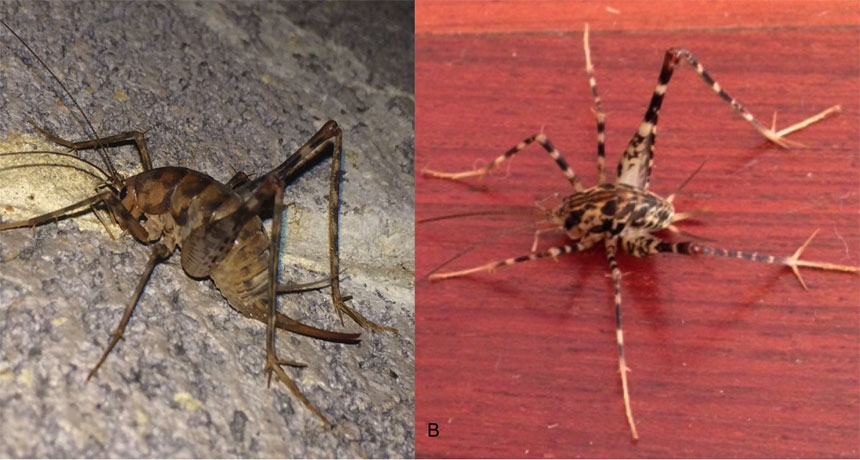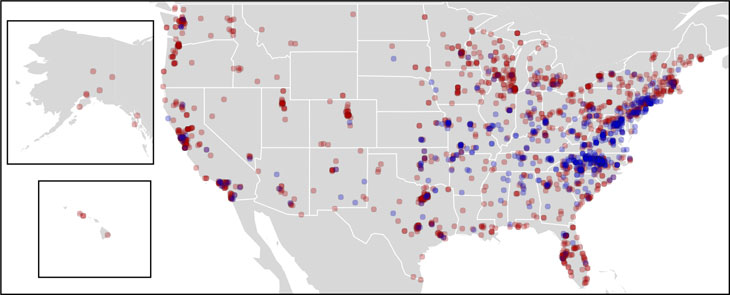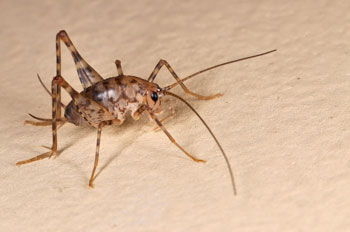Citizen scientists spy on camel crickets
Hiding in dark basements and garages, these insects live across the United States

Cricket, spricket! These camel crickets (two species shown above) are living in people’s basements and garages. A new study shows how far they’ve spread.
M.J. Epps et al/PeerJ 2016
As spring approaches, they return. I step into my cool, dark garage and see them out of the corner of my eye. Big, brown, humped bodies with bent legs splayed in a circle. The lurking insectoid shapes — on the floor and sometimes clinging to the walls — are the size of my thumb. Spiders? I tentatively step forward. One of them bounds several feet in the air. It seems to be aiming right for my face.
Phew. Just camel crickets.
They’re in my garage, but where else do these big-bodied jumping wonders live? To find out, scientists at North Carolina State University in Raleigh sent out a call to citizen scientists. They asked whether camel crickets lived in their houses and if they could send photos or even the crickets themselves to the scientists for study. Hundreds of people responded. Scientists have collected data showing just where these big bugs are hanging out in the United States. It shows that there’s not just one species of camel cricket hanging out in houses. Instead there might be three — and one of them may be a new invader.
Camel crickets may be big and living in our homes, but these insects — sometimes called “sprickets” for “spider cricket” or “springy cricket” — remain mysterious. “They’re living literally right under our feet and we know so little about them,” says Morgan Jackson. He’s an entomologist — a scientist who studies insects — in graduate school at the University of Guelph in Ontario, Canada. He was not involved in the paper. They are called camel crickets, Jackson says, probably because “if you look from the side they have this huge hump,” like that of a camel. Except with a lot of extra legs.
Scientists have reported camel crickets underfoot in the United States since 1920, but “they’ve been under the radar,” says Holly Menninger. She studied ecology at North Carolina State. They are related to crickets that live under logs and in damp dark places on the forest floor, as well as to large, pale crickets that inhabit caves. Camel crickets don’t bite, aren’t poisonous and don’t cause damage to our food or crops. That might be why they get ignored, she says.
But when Menninger and a group of scientists at North Carolina State decided to ask homeowners what kind of animals lived in their houses, the spricket mentions came bounding in. So the scientists, led by Robert Dunn, decided to do a study on just where these camel crickets were hopping.
Studying sprickets
The scientists asked anyone on the Internet to fill out a survey about whether camel crickets lived in and around their homes. They got 549 responses with 244 reporting that they had crickets. Then, they sent out another survey to a separate group, participating in a completely different study. This survey was actually about the microbes living in their homes — not the insects or other animals. But the scientists included a picture of a camel cricket anyway.
That second survey was especially important, says Jackson. Scientists don’t want to only sample people who’ve heard of sprickets. That might make the sample biased — people would be more likely to take the survey if they had crickets to report. So it makes sense to ask people randomly about the cricket. “It’s great to know which cities they’re found in,” Jackson says. But “it’s just as important to know where they aren’t.” Finding out where the camel crickets do and don’t spend their time can tell you more about how they live their lives, he explains.
More than 2,200 households responded to the camel cricket surveys. Of those, 669 houses reported that they had sprickets bouncing about — about 30 percent. Most of the houses with crickets were east of Colorado, with large concentrations in eastern states such as North Carolina and Virginia.
(Story continues below map)

But were the crickets indoors only? To find out, Nathan La Sala — then a high school student at Enloe High School in Raleigh — enlisted to help the scientists out. He and the other scientists placed plastic cups in the ground around 10 houses near Raleigh — including houses with and without camel crickets. The plastic cups held a little bit of molasses and water and were covered to protect them from the rain — perfect traps for hungry bugs. The crickets jump in and then drown in the water. After two days, the scientists recovered 158 crickets. Most were within just one meter (one yard) of the house — showing that sprickets like to stay close to home.
Finally the scientists asked for photos — and samples — of the crickets people reported, so they could identify which species were present. “Most people would catch them and then freeze them and send them in a little plastic container,” says Menninger. “We did get some in envelopes that … did not do well.” But the samples were enough to identify two species. One — a cricket from the genus Ceuthophilus — is native to the Untied States and was reported in about 12 percent of photos and samples. The other — Diestrammena asynamora — is a species that is originally from Asia. This invasive species accounted for 88 percent of reports.
Or did it?
When looking through the photographs, the scientists noticed something odd. Some of the camel crickets from the northeastern states — such as Massachusetts — didn’t look quite like D. asynamora. Instead of being generally brown, these crickets had bold stripes. It could be another species, D. japanica.

Science in your basement
The study will help scientists understand where camel crickets have spread. The team couldn’t have done it without the help of citizen scientists, Menninger says. “It allowed us to sample broadly across wide areas, more than we could do on our own,” she explains. In addition, people might not like to let scientists walk into their houses to see if they have crickets. So asking them to report in helps a lot, Menninger notes.
Analyzing sprickets may seem like fun and games, but LaSala — now a biology major at the University of North Carolina in Asheville — says he learned better. Even setting plastic cup traps “isn’t all fun,” he says. “There’s a lot of hard work involved.” But it didn’t turn him off. Instead, his findings reinforced his love of science. He’d like to be a zoologist — someone who studies animals and where they live.
The next step will be to find out if camel crickets have any effects on other insects living nearby. “We assume they’re harmless, they won’t make much difference in our lives,” Jackson says. But “we don’t know whether they’re having any effect on the native species.”
But the study shows something else, Jackson says. It shows there’s science to be done in your own house — science on species that aren’t already well described. “We’ve done a good job [learning about] birds and mammals … things that are big and showy,” he says. But many smaller animals live, virtually unknown, right under our noses. Crickets have been around us all this time, he says, and “we just never bothered to look.”
The new study might make a good excuse to go down to the basement, see what’s down there and watch what its doing. “It’s a new part of the ecosystem,” Jackson says. He hopes the results will encourage people to “go and look at them and not be freaked out.” And the best part of doing science in the basement? You might be doing biology in a natural habitat, but “you won’t ever get rained on.”
Follow Eureka! Lab on Twitter
Power Words
(for more about Power Words, click here)
bias The tendency to hold a particular perspective or preference that favors some thing, some group or some choice. Scientists often blind subjects to the details of a test so that their biases will not affect the results.
biology The study of living things. The scientists who study them are known as biologists.
bug The slang term for an insect. Sometimes it’s even used to refer to a germ.
camel cricket A family of crickets related to crickets that live in caves. These crickets usually are associated with people’s homes, or with damp dark logs and other areas of the forest floor. They have large, drumstick-shaped back legs and a big arch in their body, making them appear humped like a camel.
citizen science Scientific research in which the public — people of all ages and abilities — participate. The data that these citizen “scientists” collect helps to advance research. Letting the public participate means that scientists can get data from many more people and places than would be available if they were working alone.
cricket A family of leaping insects. Crickets are found all over the world, and more than 900 cricket species exist.
ecology A branch of biology that deals with the relations of organisms to one another and to their physical surroundings. A scientist who works in this field is called an ecologist.
ecosystem A group of interacting living organisms — including microorganisms, plants and animals — and their physical environment within a particular climate. Examples include tropical reefs, rainforests, alpine meadows and polar tundra.
entomology The scientific study of insects. One who does this is an entomologist. A paleoentomologist studies ancient insects, mainly through their fossils.
genus (plural: genera) A group of closely related species. For example, the genus Canis — which is Latin for “dog” — includes all domestic breeds of dog and their closest wild relatives, including wolves, coyotes, jackals and dingoes.
graduate school Programs at a university that offer advanced degrees, such as a Master’s or PhD degree. It’s called graduate school because it is started only after someone has already graduated from college (usually with a four-year degree).
habitat The area or natural environment in which an animal or plant normally lives, such as a desert, coral reef or freshwater lake. A habitat can be home to thousands of different species.
insect A type of arthropod that as an adult will have six segmented legs and three body parts: a head, thorax and abdomen. There are hundreds of thousands of insects, which include bees, beetles, flies and moths.
invasive species (also known as aliens) A species that is found living, and often thriving, in an ecosystem other than the one in which it evolved. Some invasive species were deliberately introduced to an environment, such as a prized flower, tree or shrub. Some entered an environment unintentionally, such as a fungus whose spores traveled between continents on the winds. Still others may have escaped from a controlled environment, such as an aquarium or laboratory, and begun growing in the wild. What all of these so-called invasives have in common is that their populations are becoming established in a new environment, often in the absence of natural factors that would control their spread. Invasive species can be plants, animals or disease-causing pathogens. Many have the potential to cause harm to wildlife, people or to a region’s economy.
mammal A warm-blooded animal distinguished by the possession of hair or fur, the secretion of milk by females for feeding the young, and (typically) the bearing of live young.
microbe Short for microorganism. A living thing that is too small to see with the unaided eye, including bacteria, some fungi and many other organisms such as amoebas. Most consist of a single cell.
random Something that occurs haphazardly or without reason, based on no intention or purpose.
species A group of similar organisms capable of producing offspring that can survive and reproduce.
specimen An individual animal, plant, biological material, rock or other item used as an example of a type or species of object or organism.
zoology The study of animals and their habitats. Scientists who undertake this work are known as zoologists.